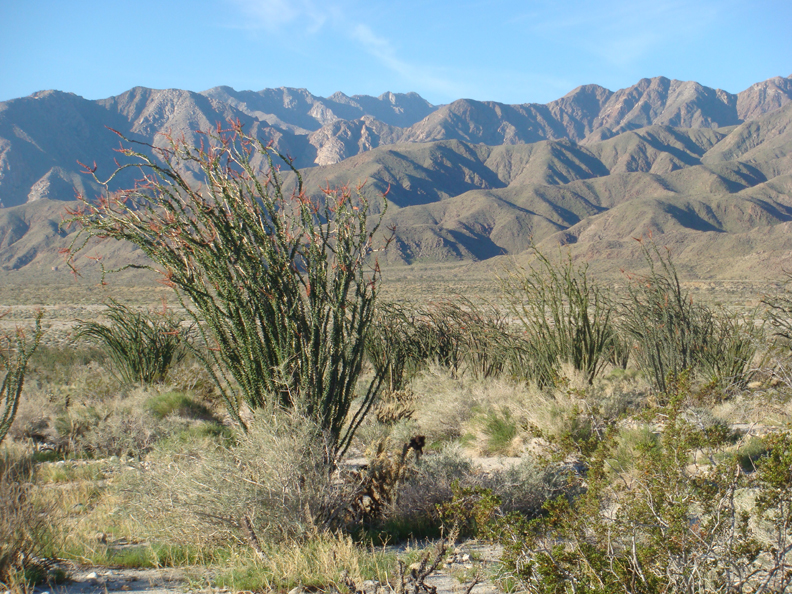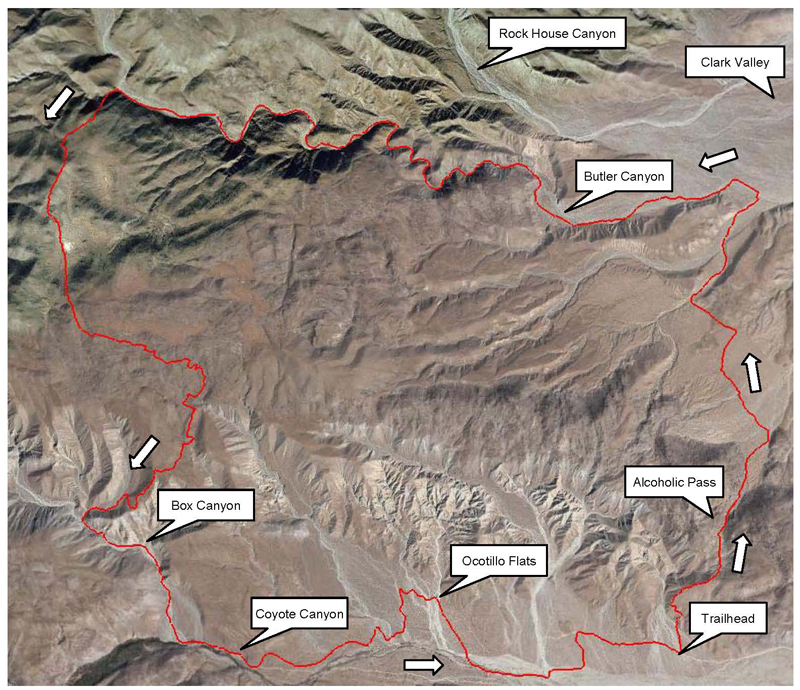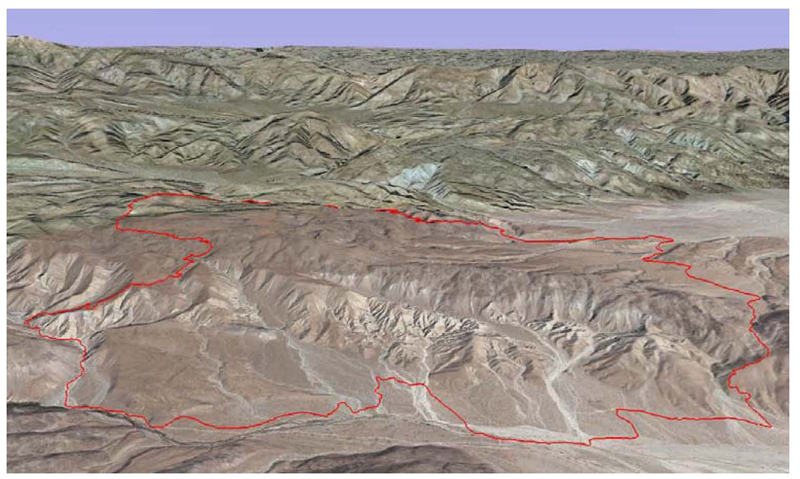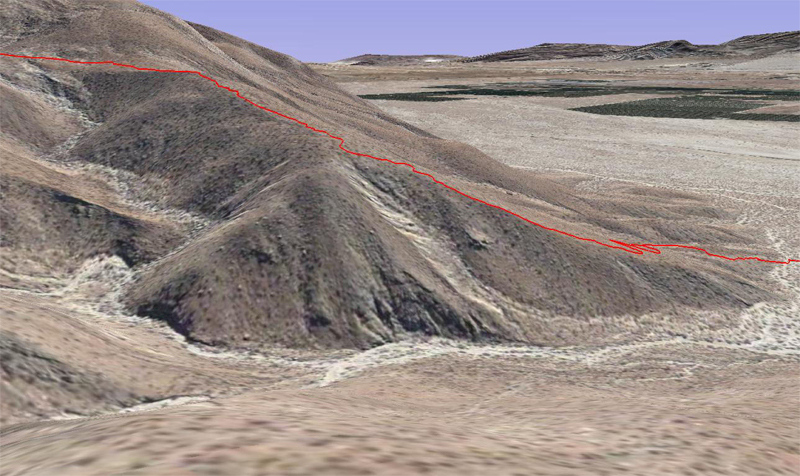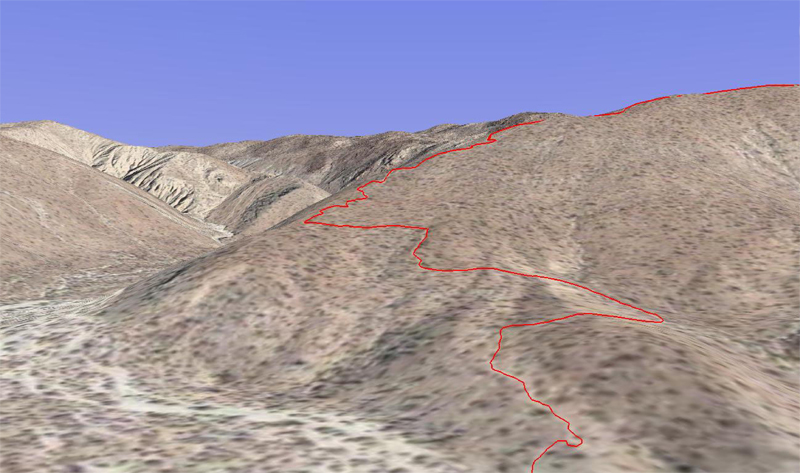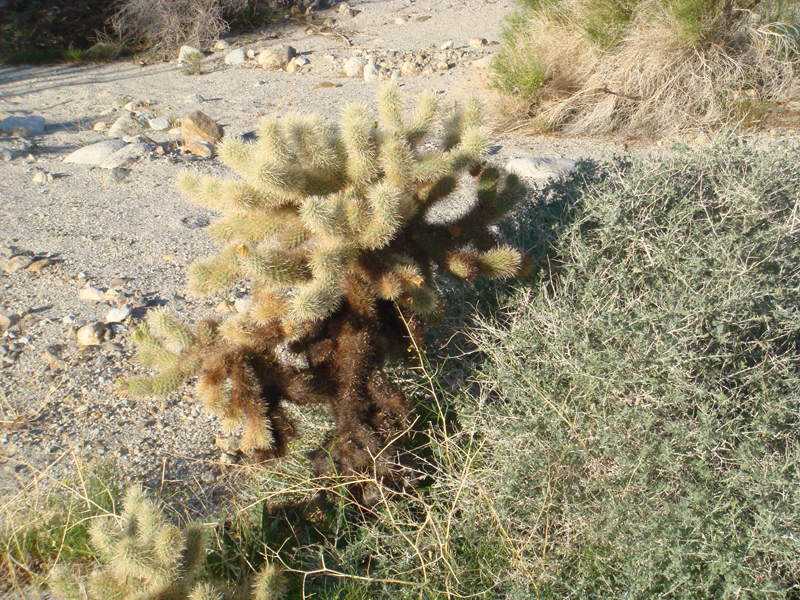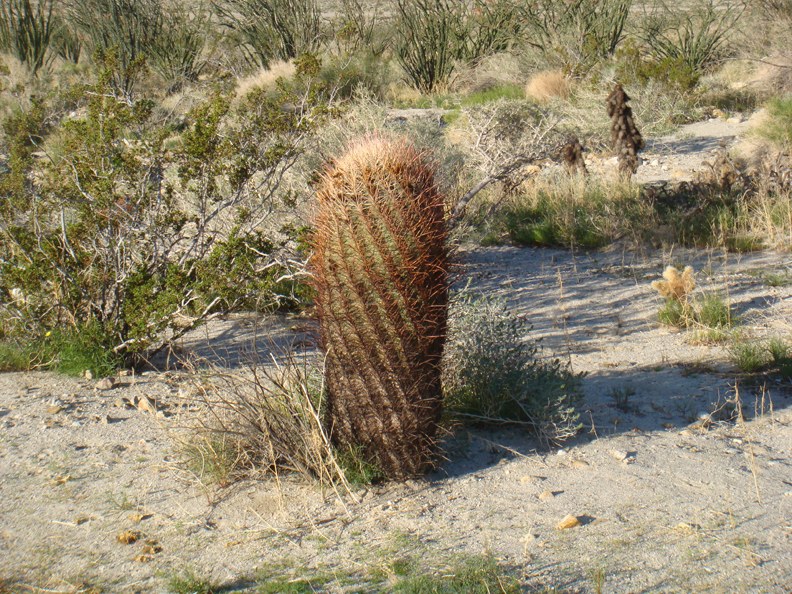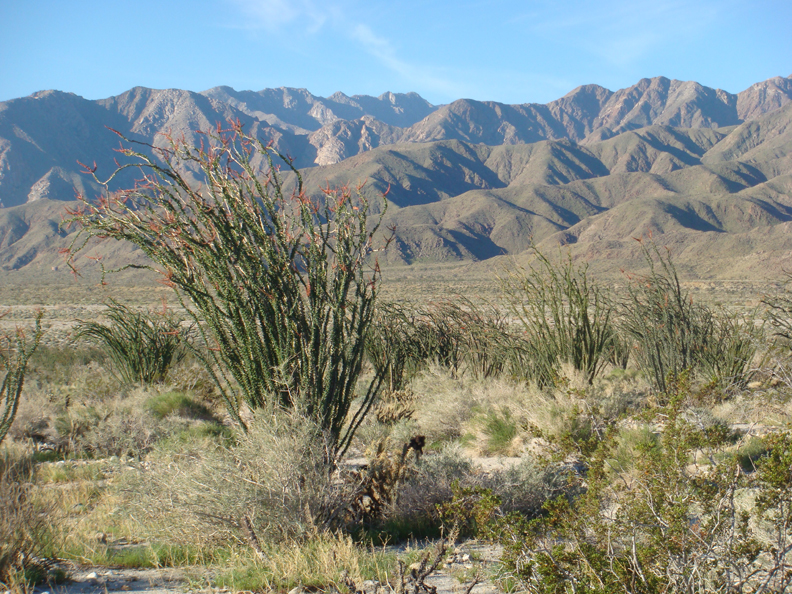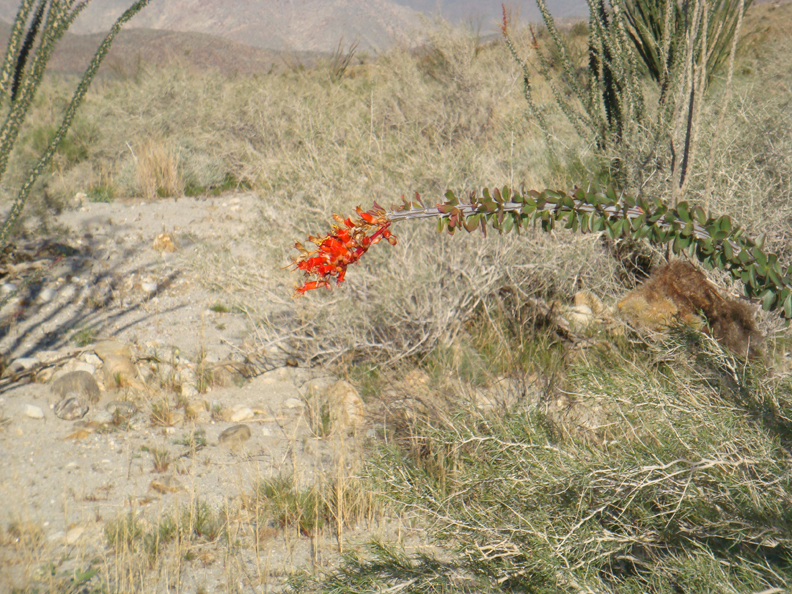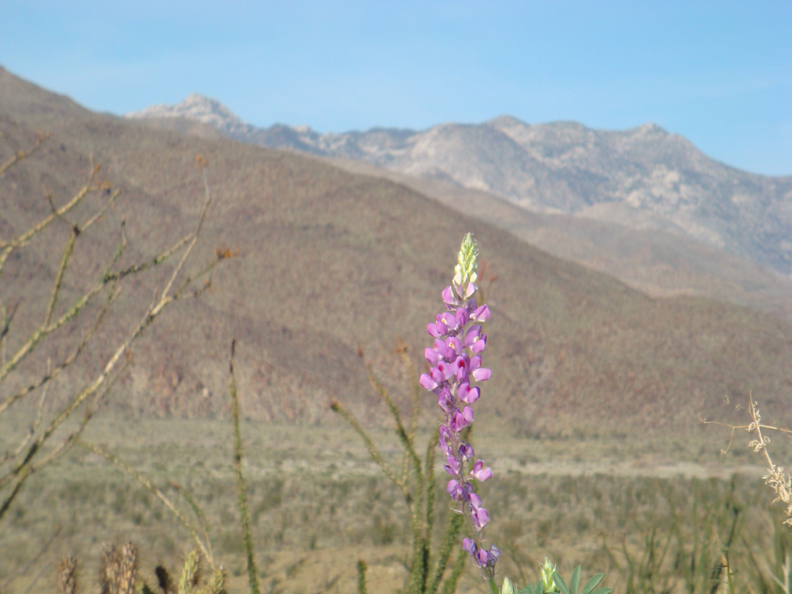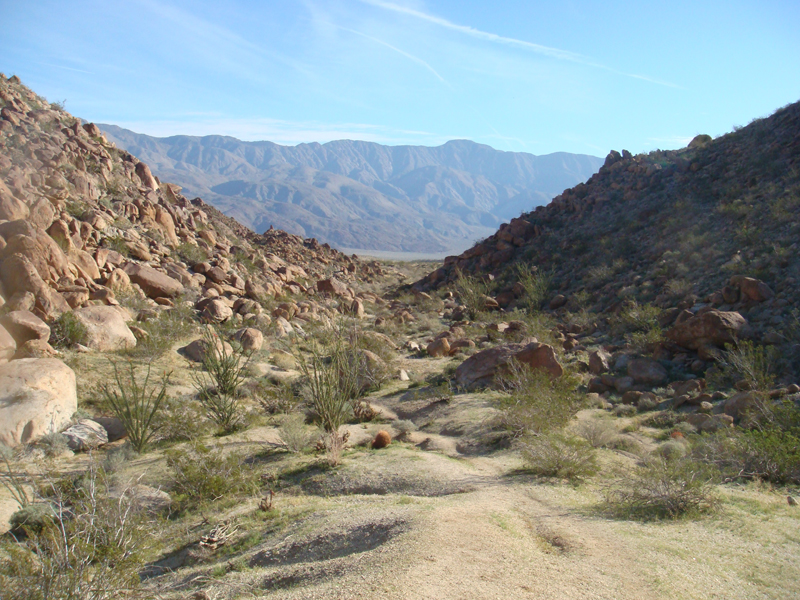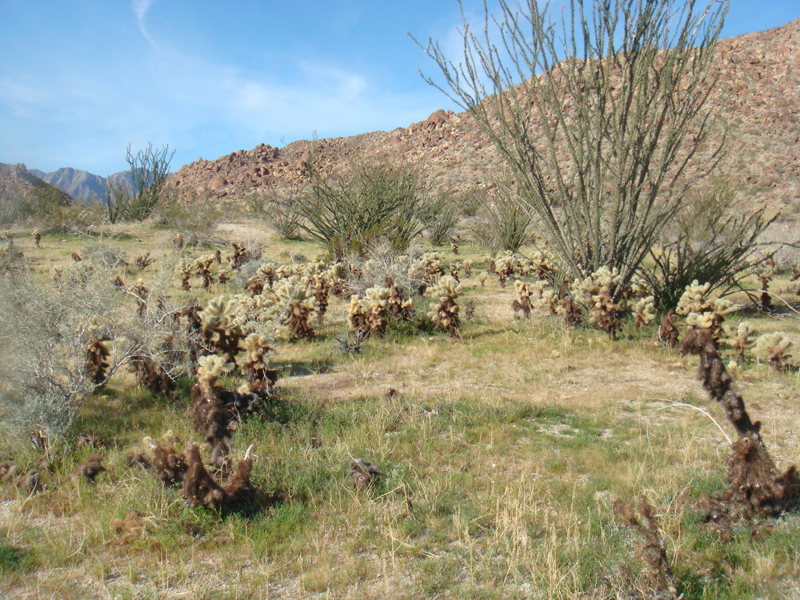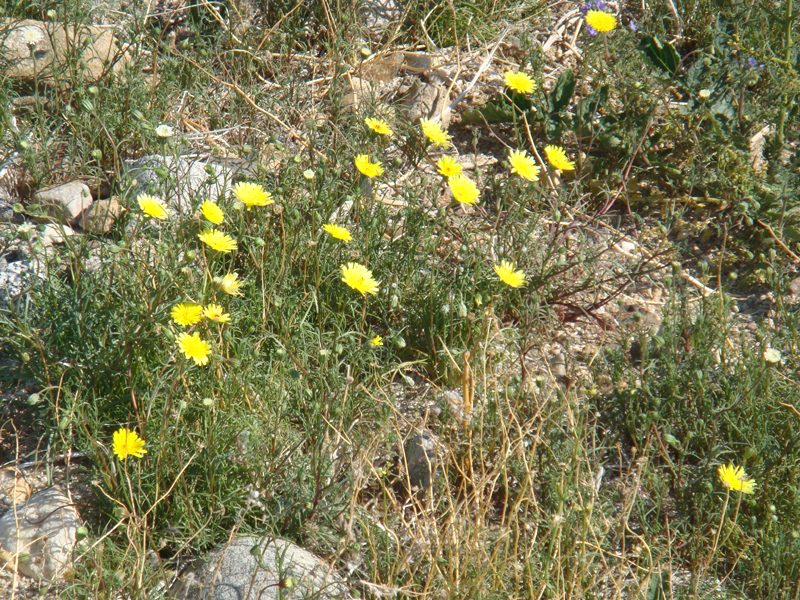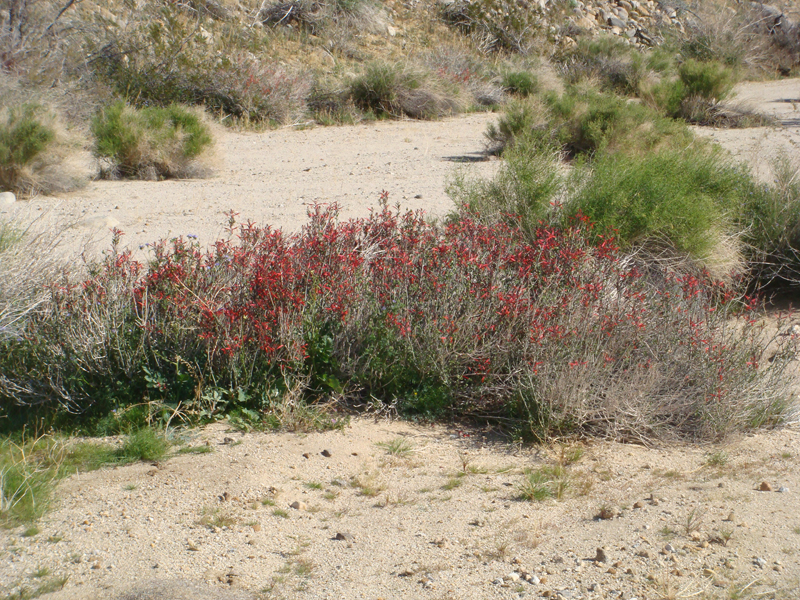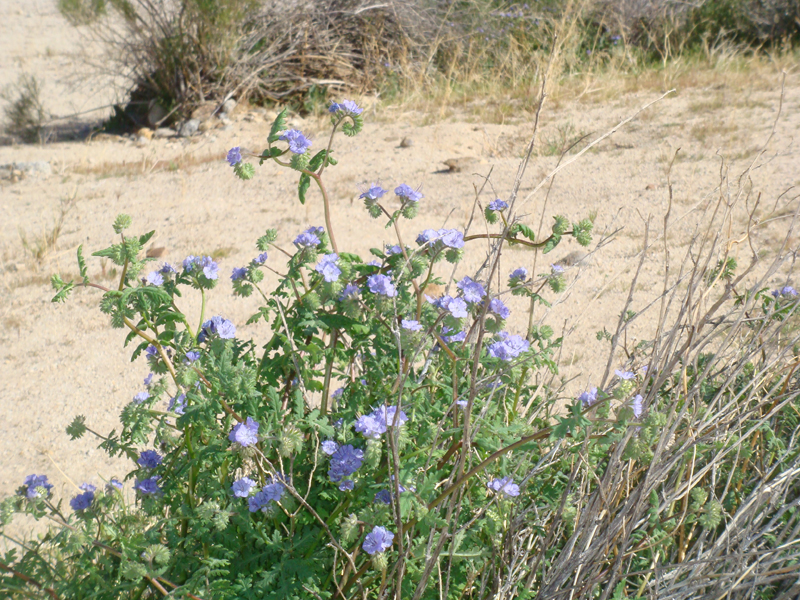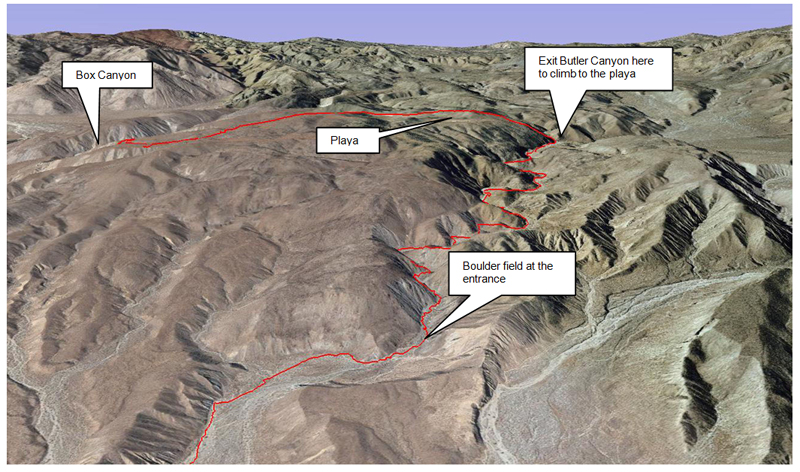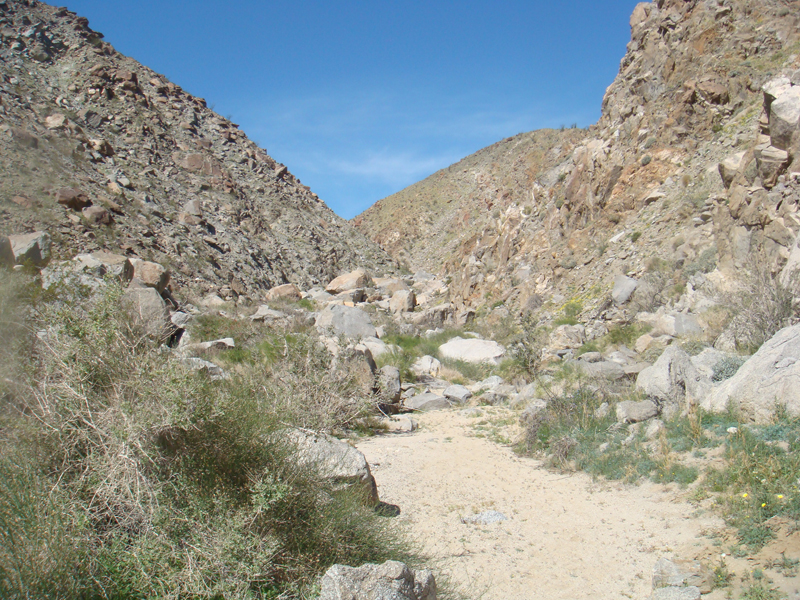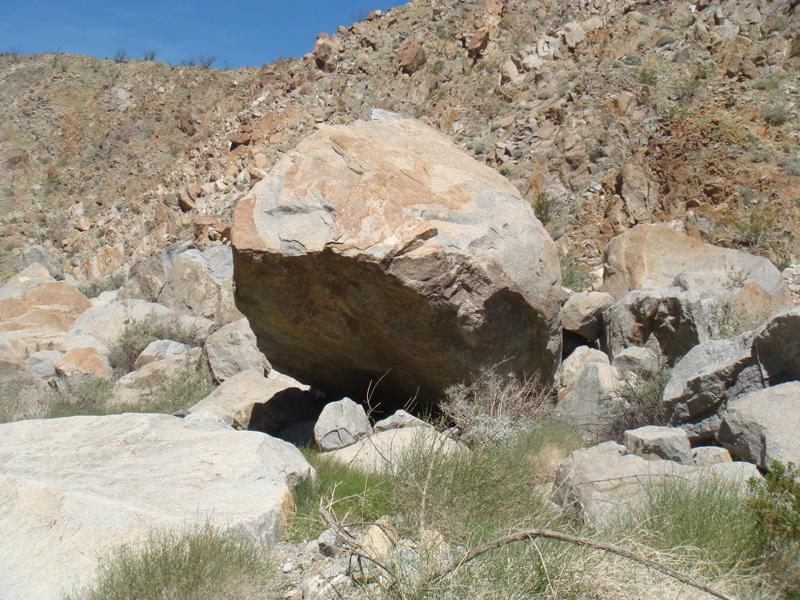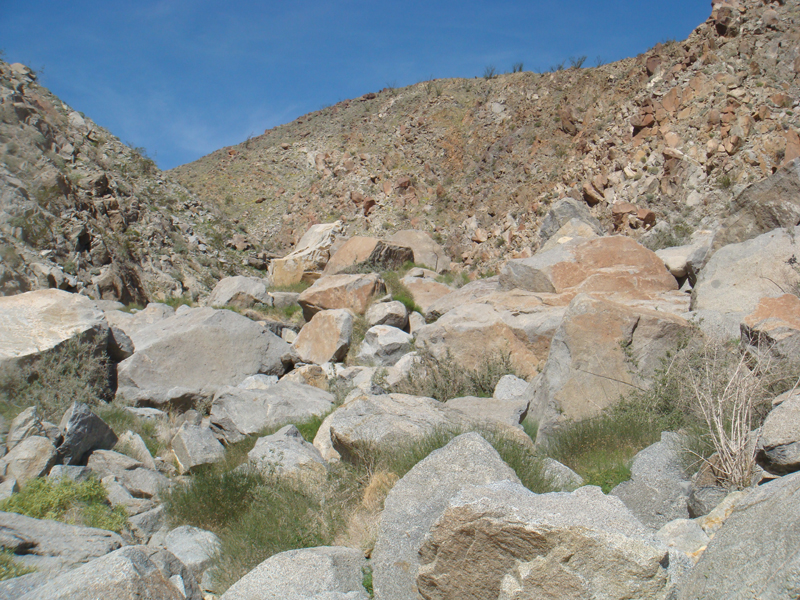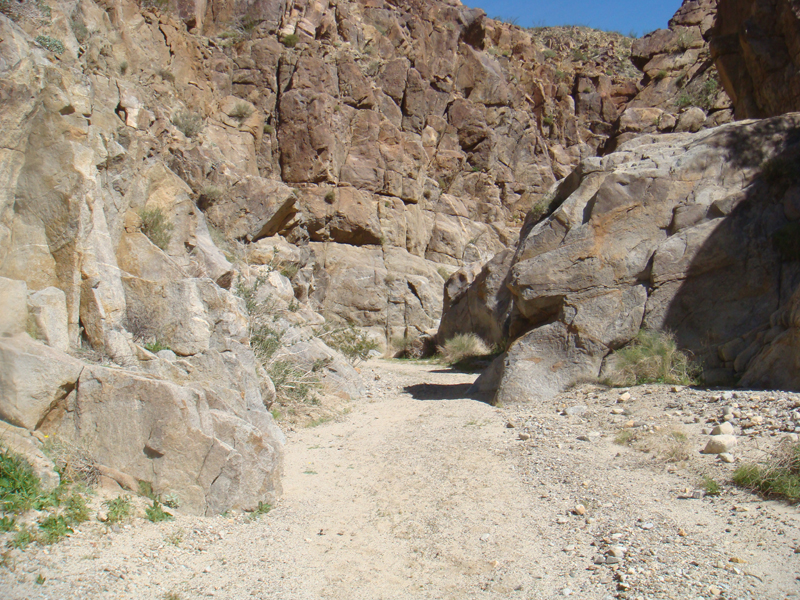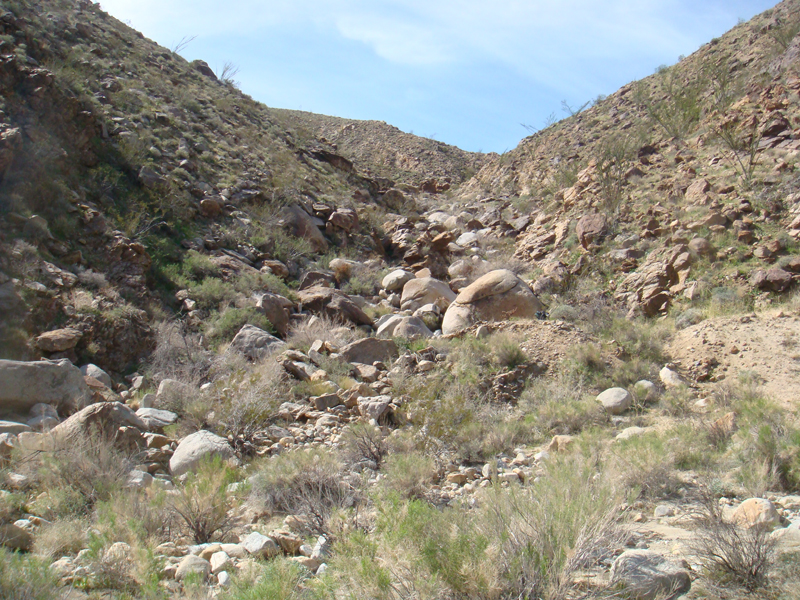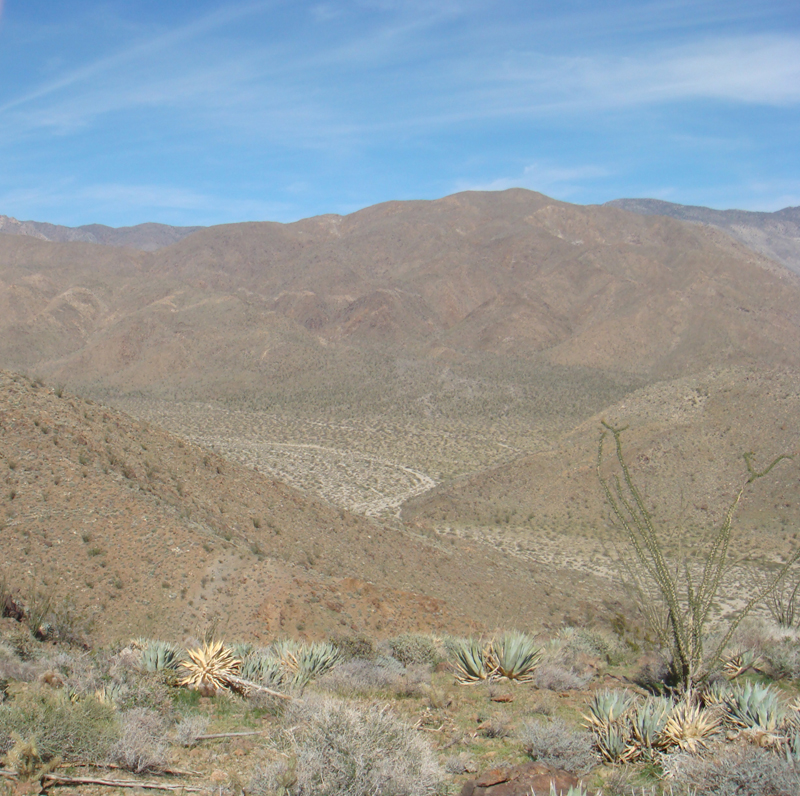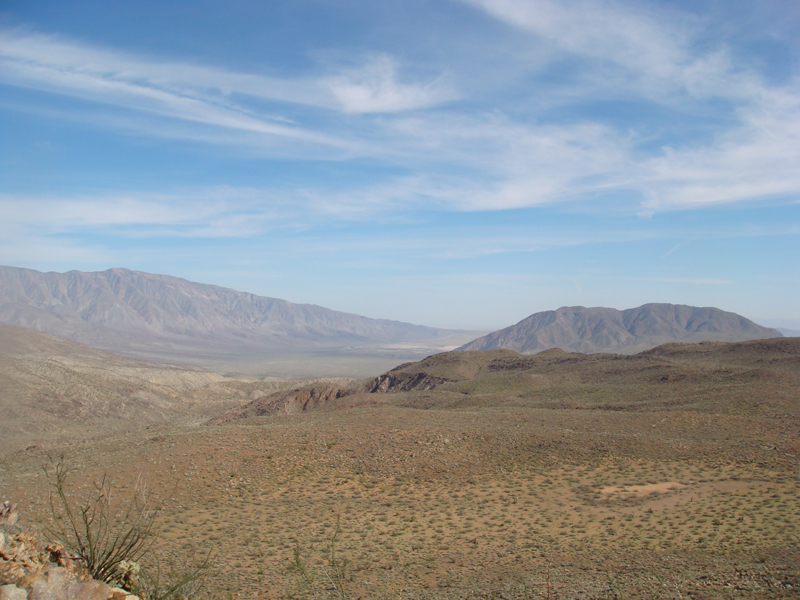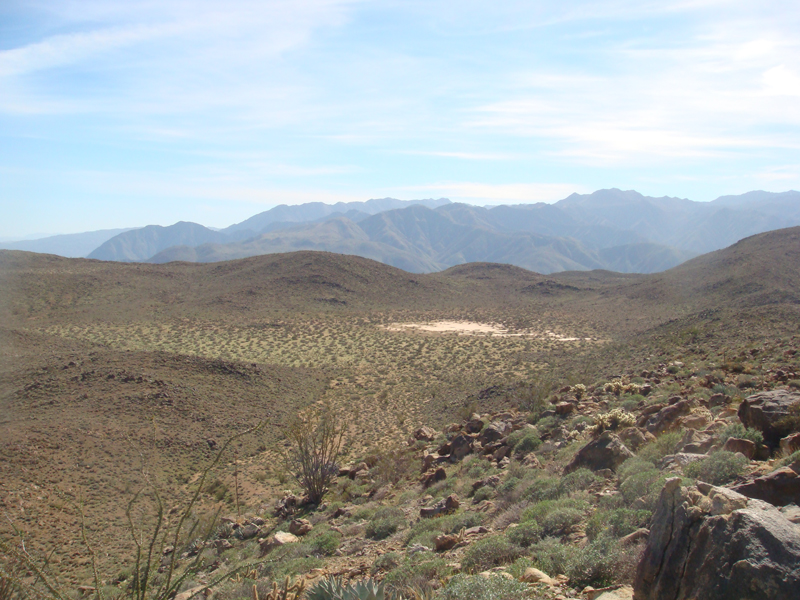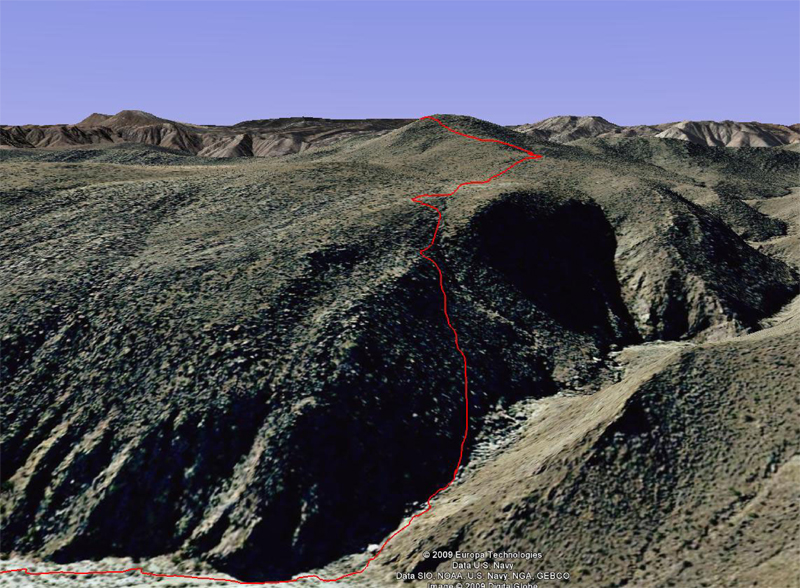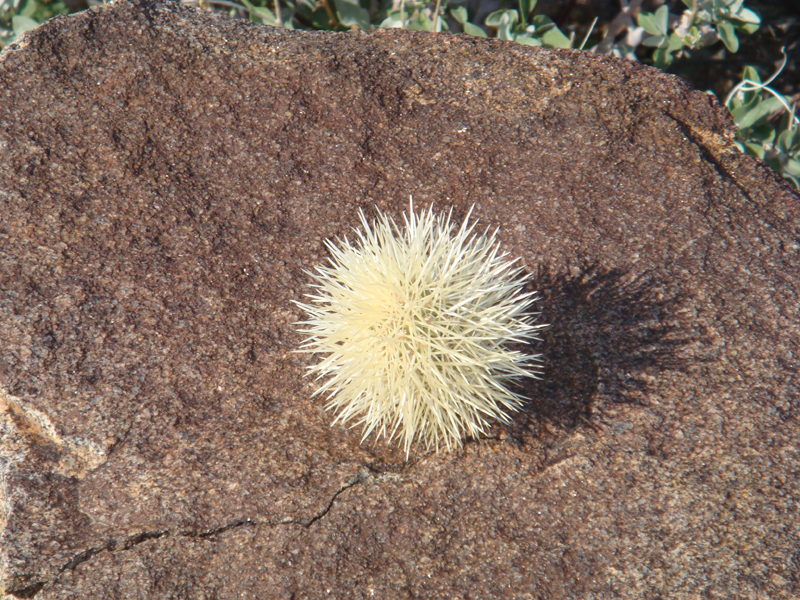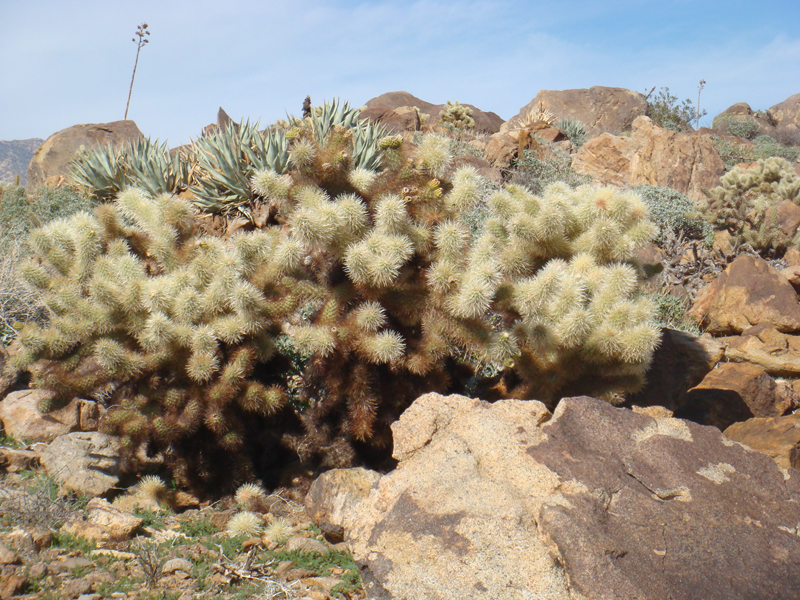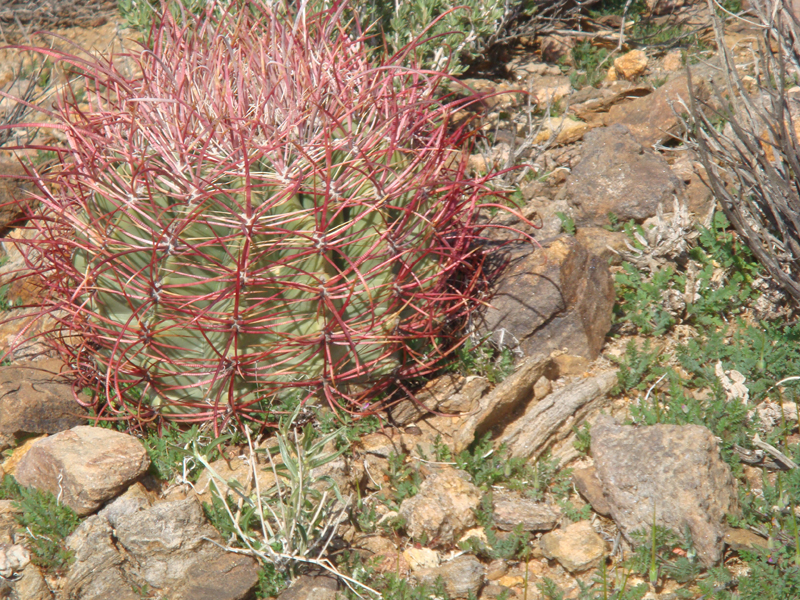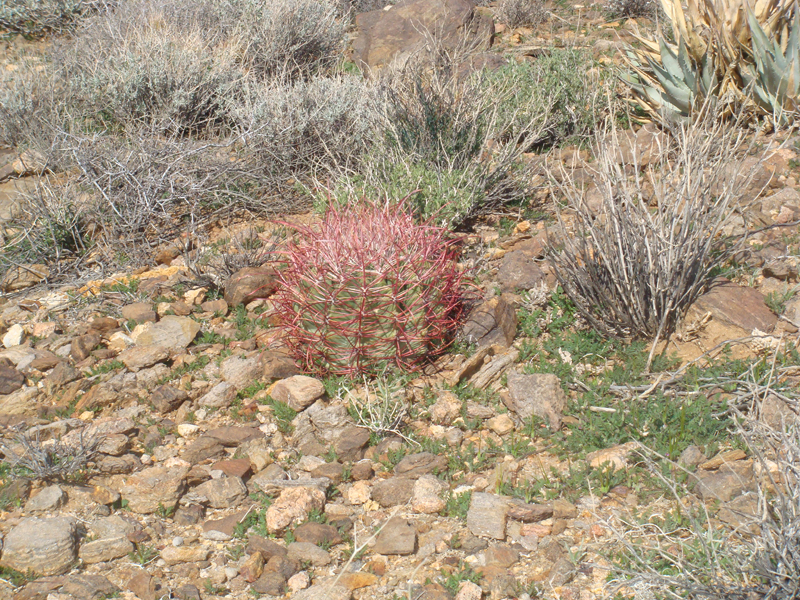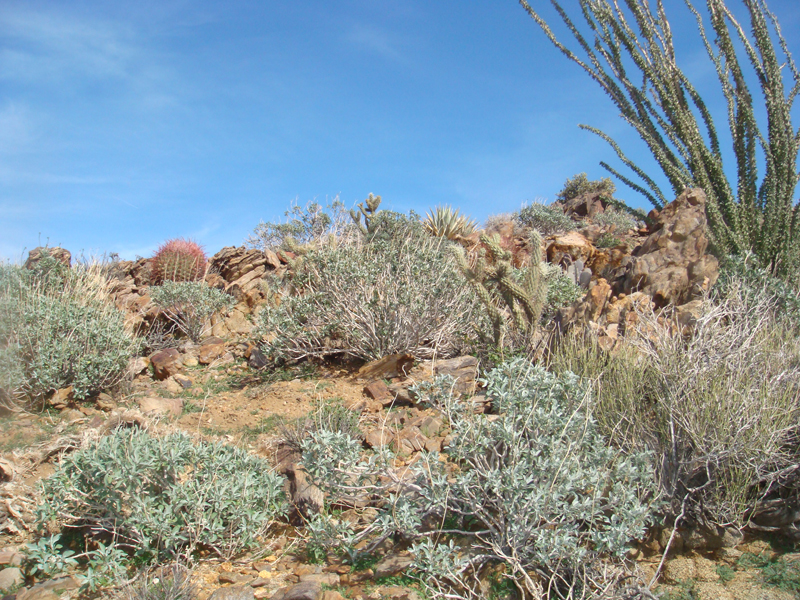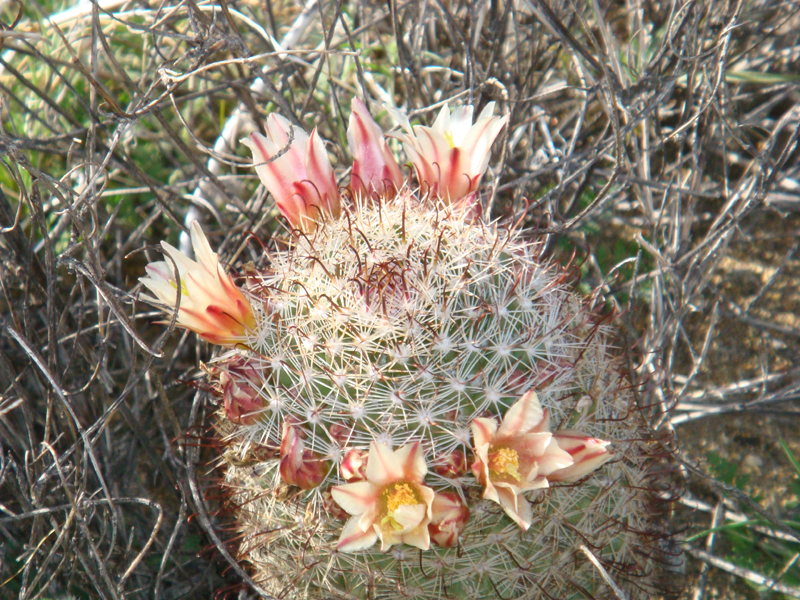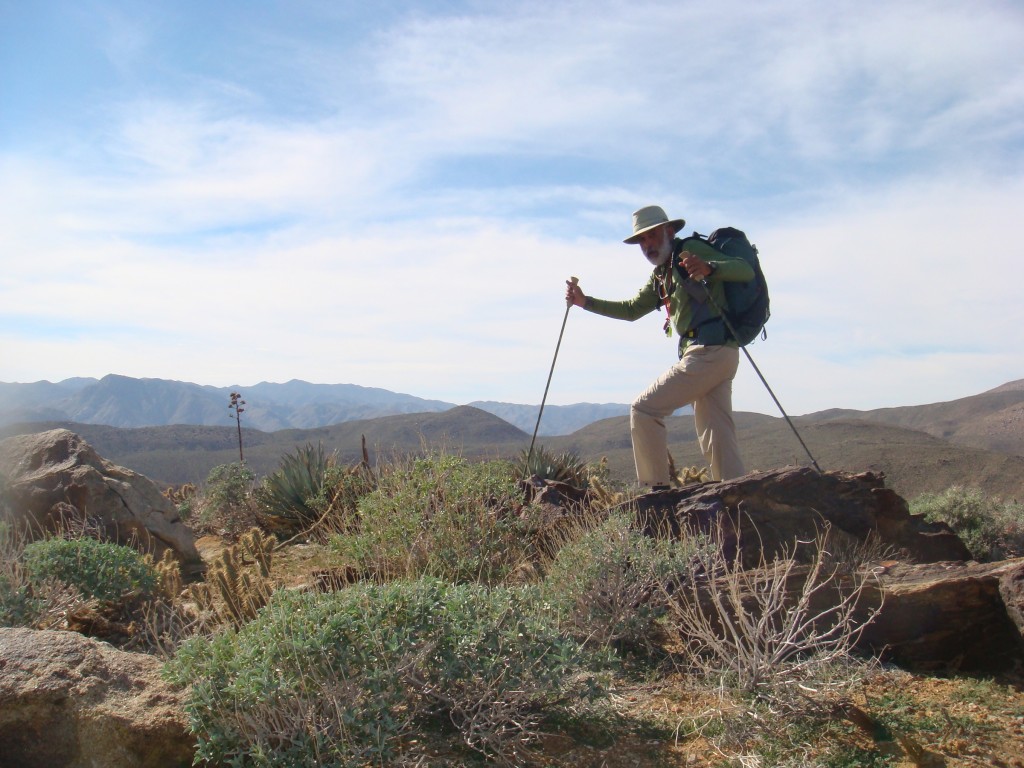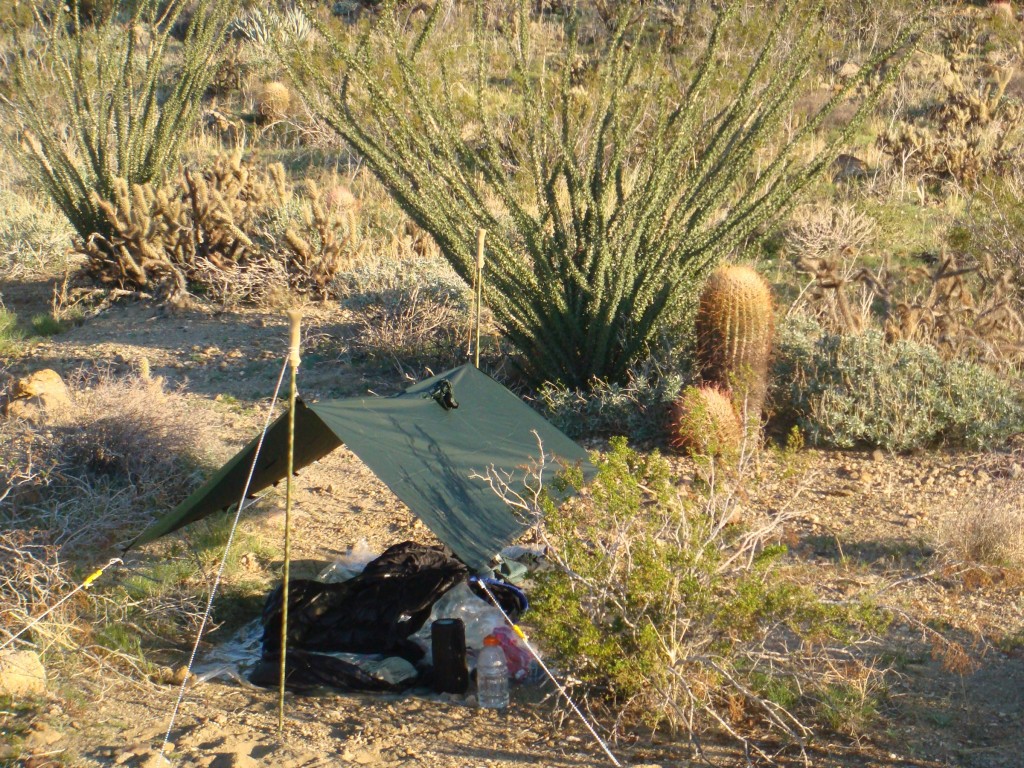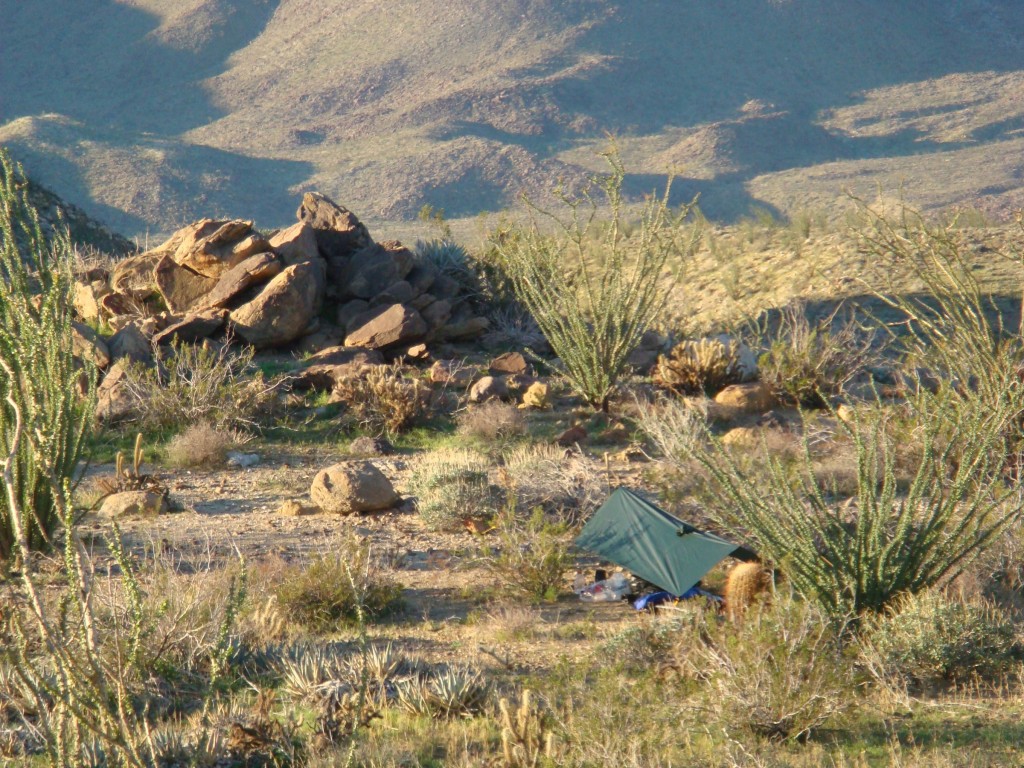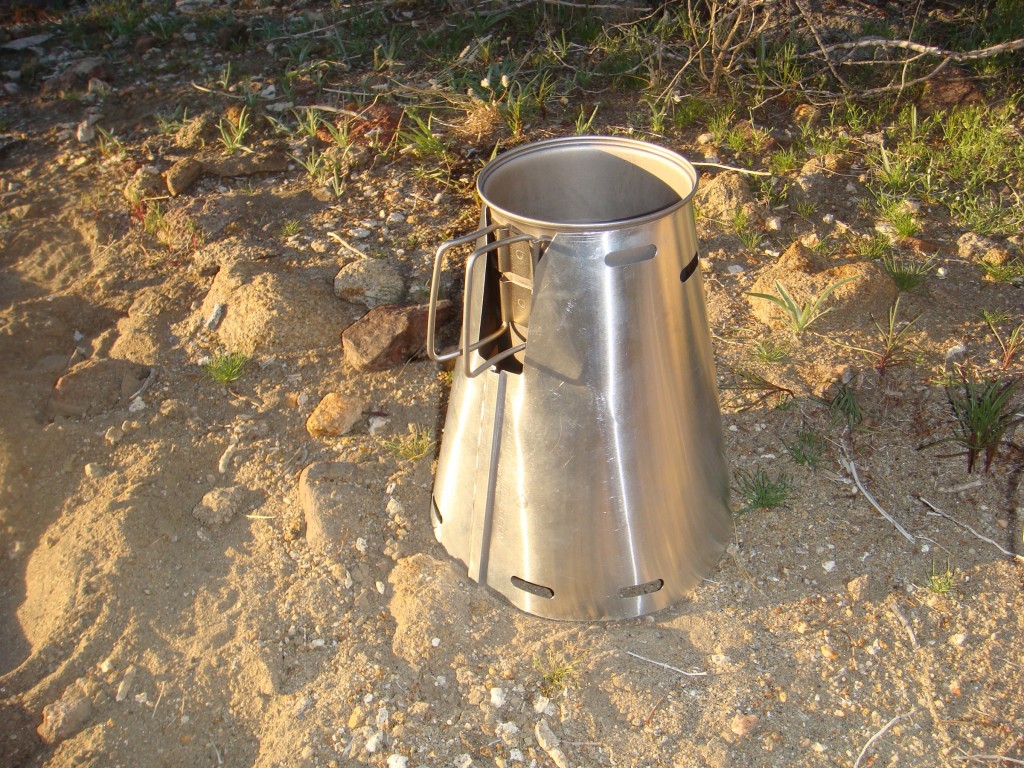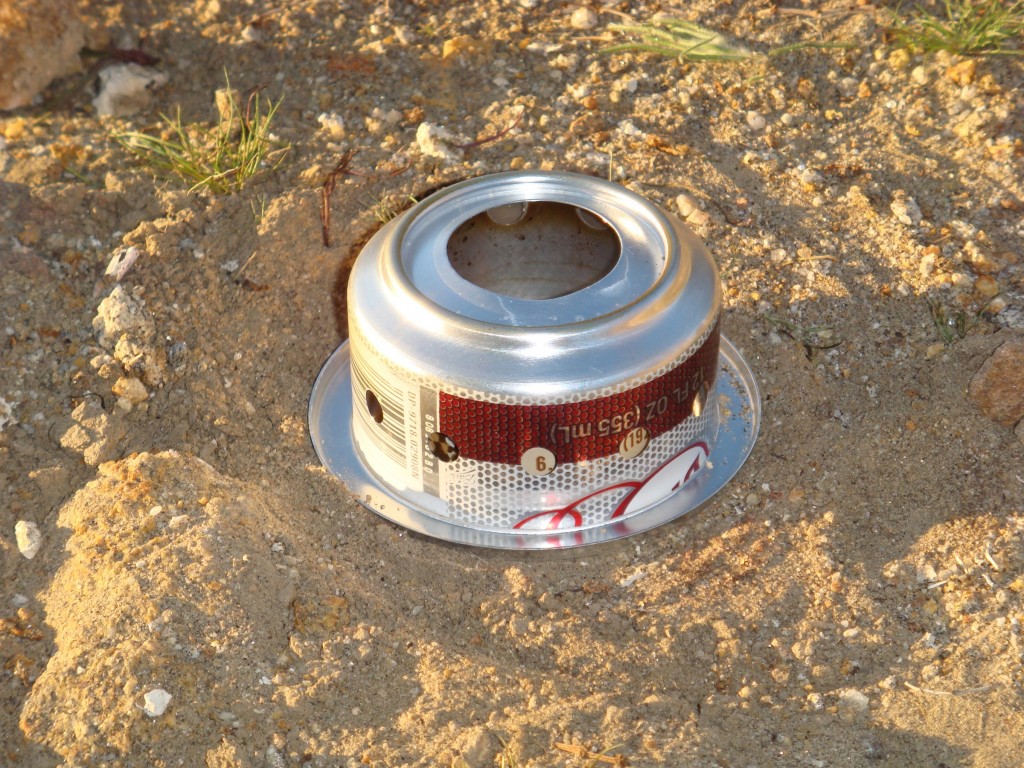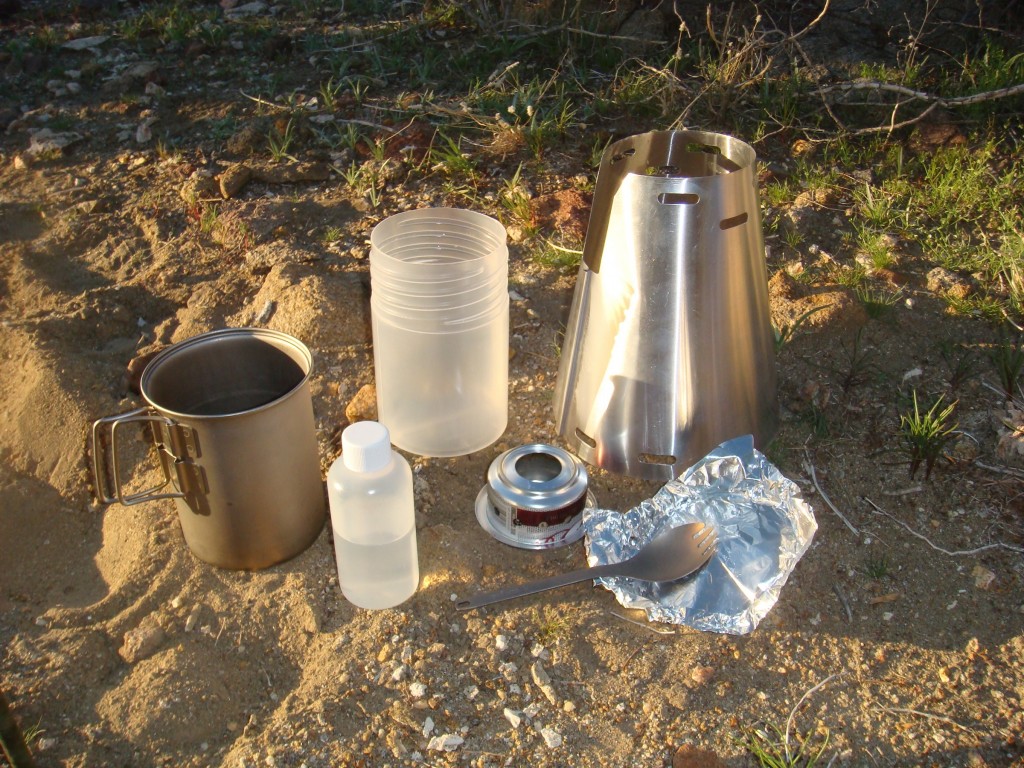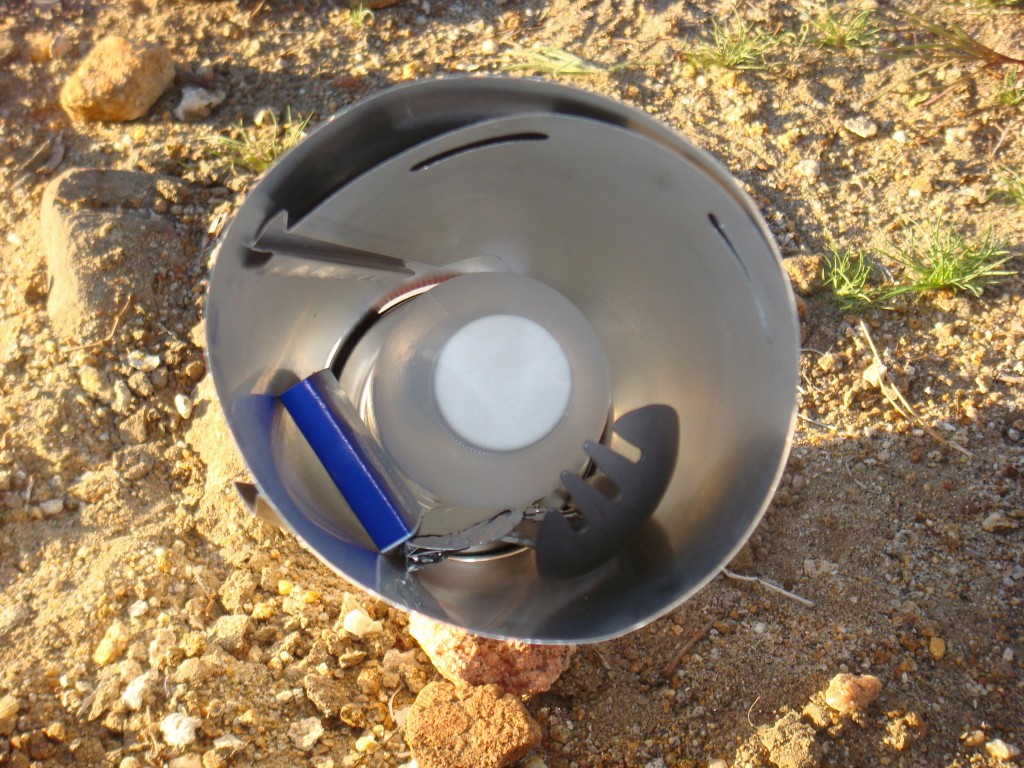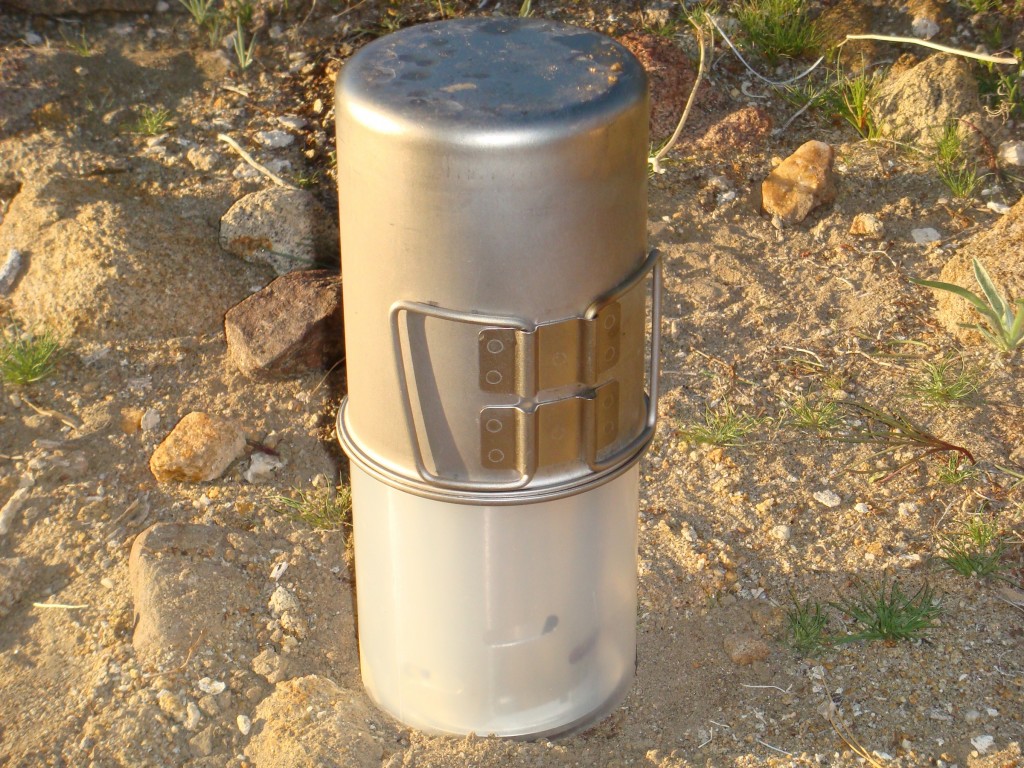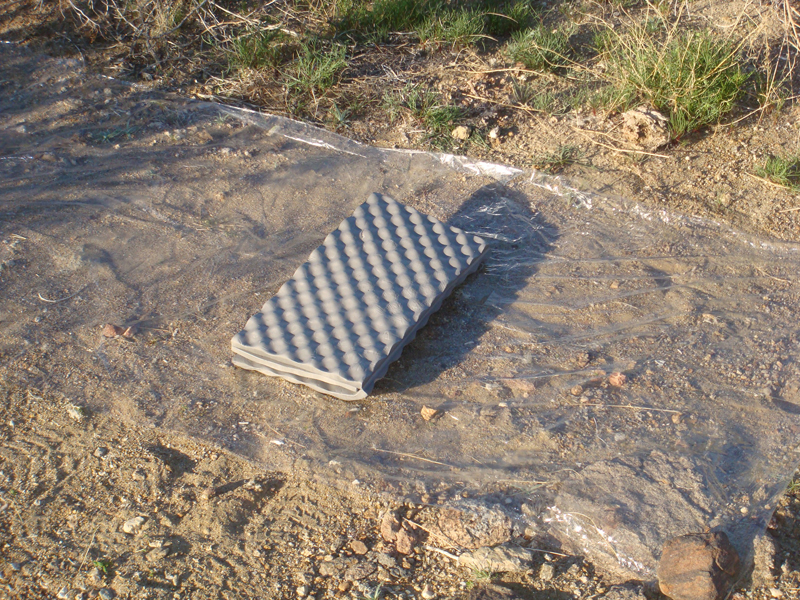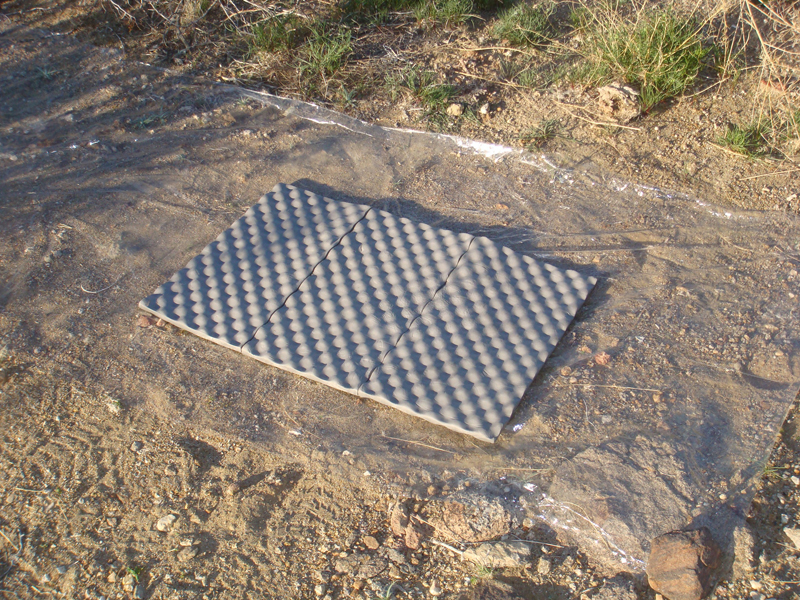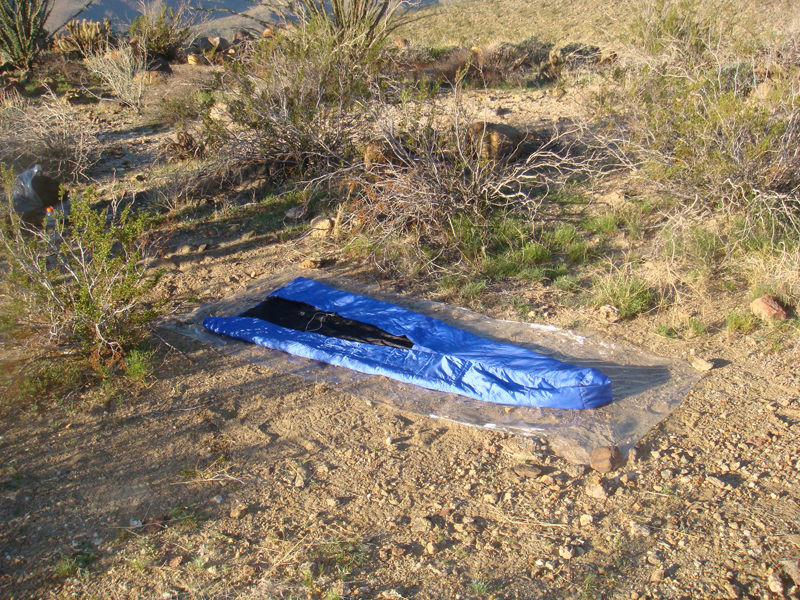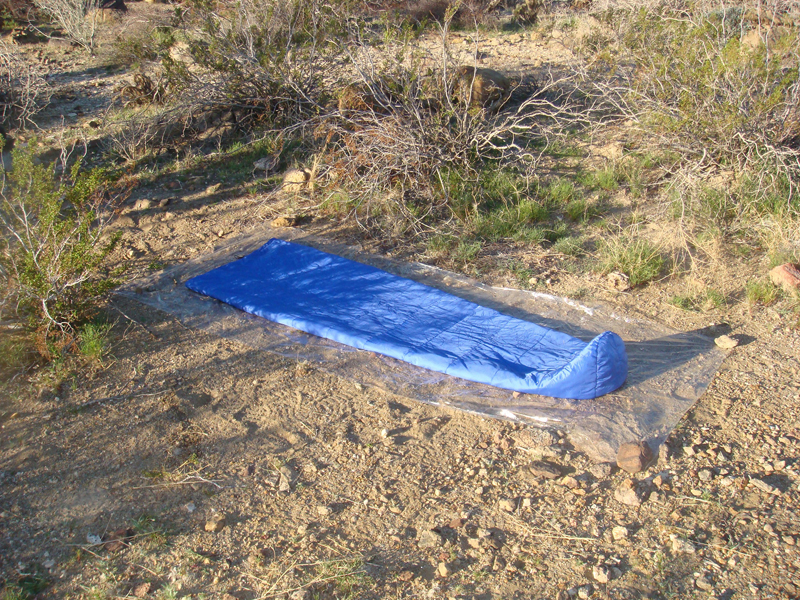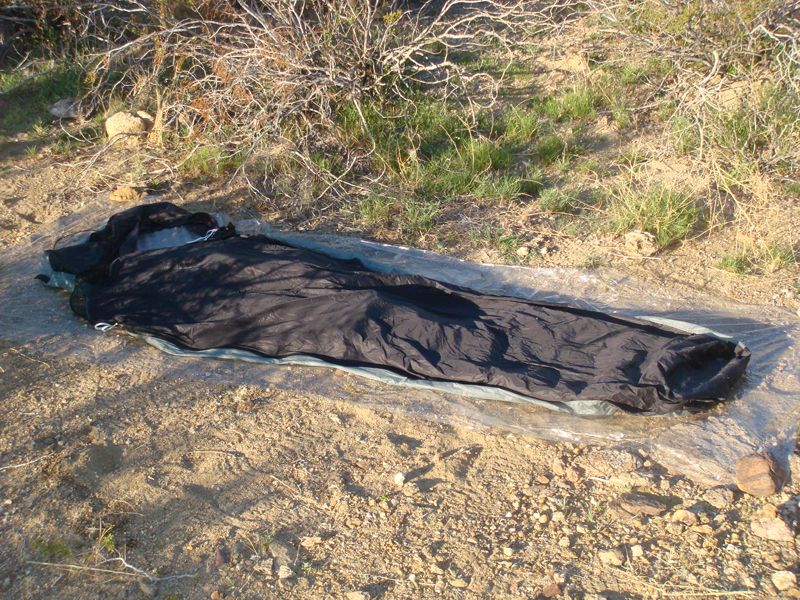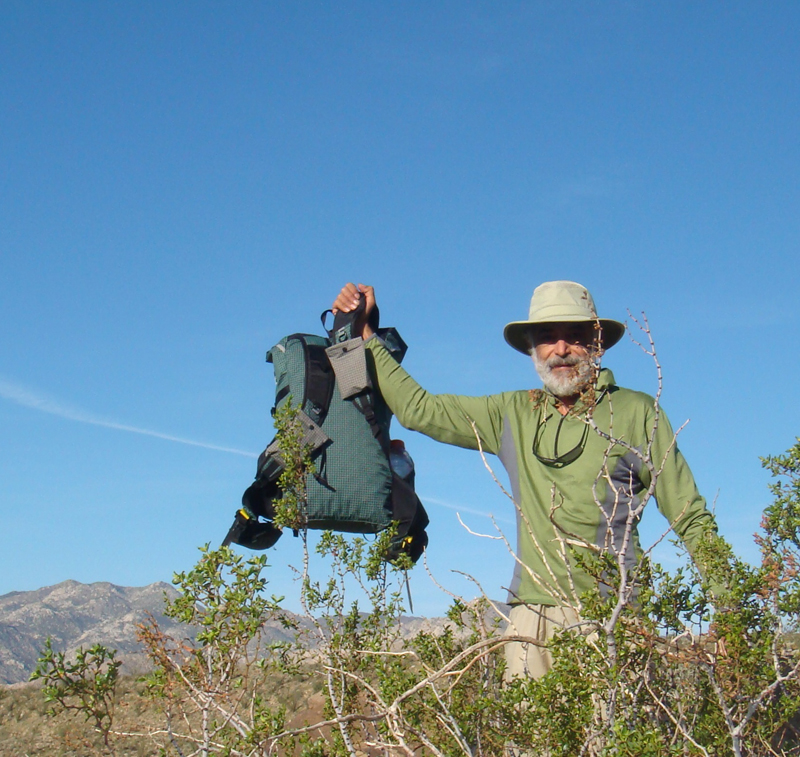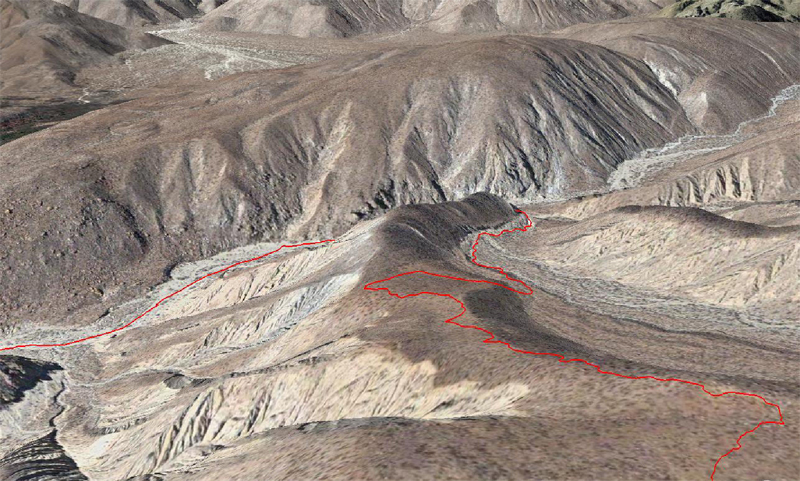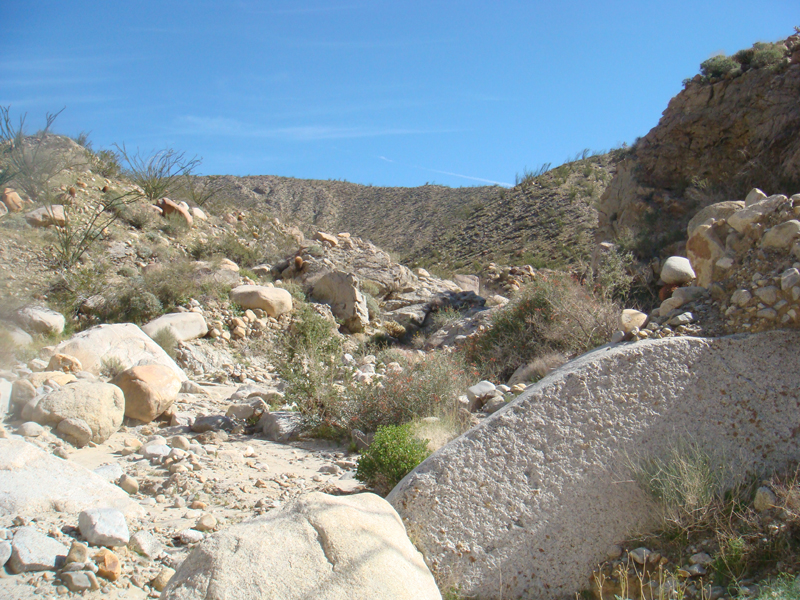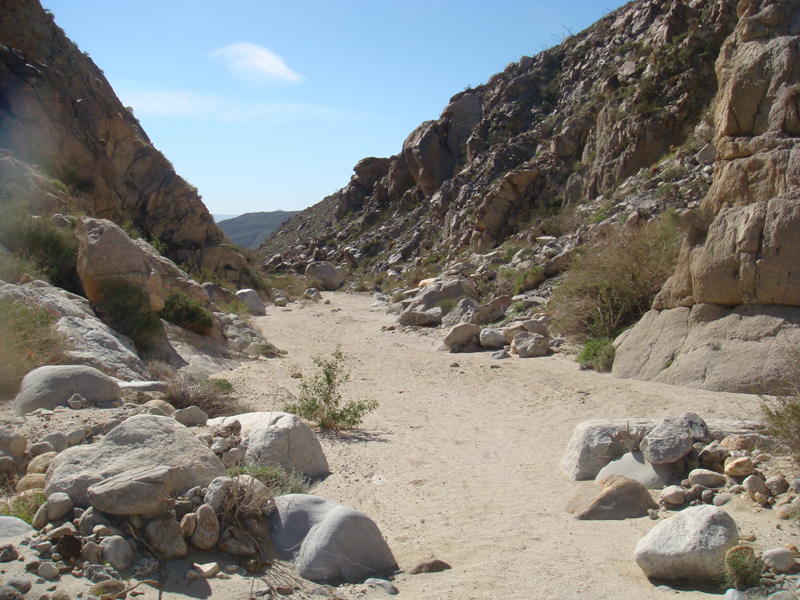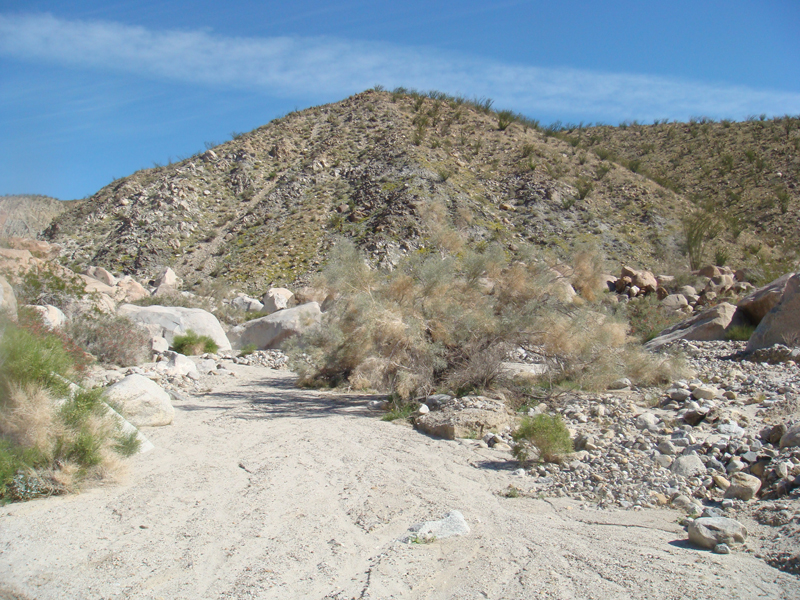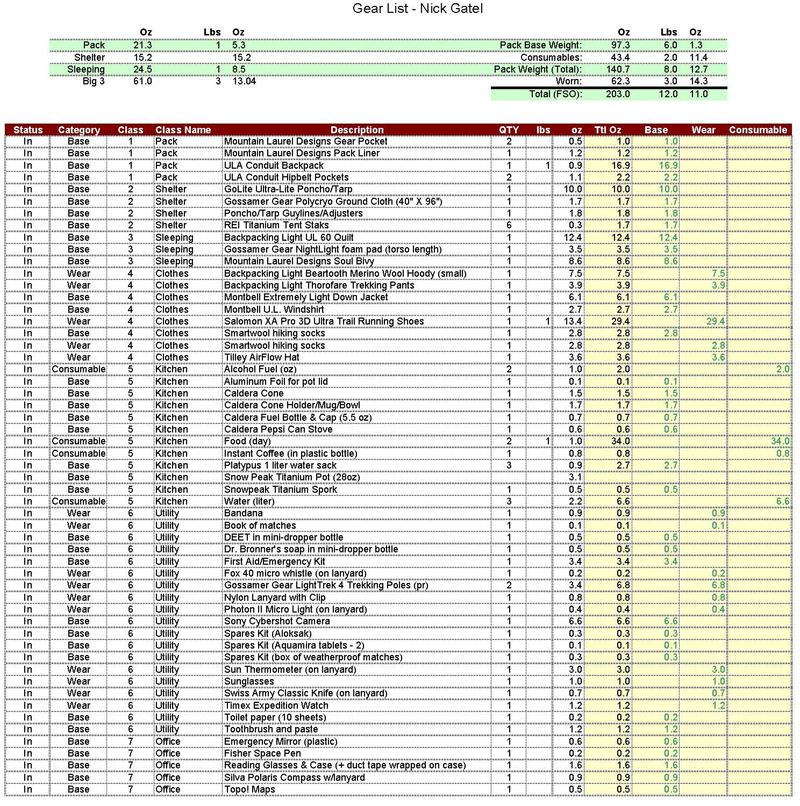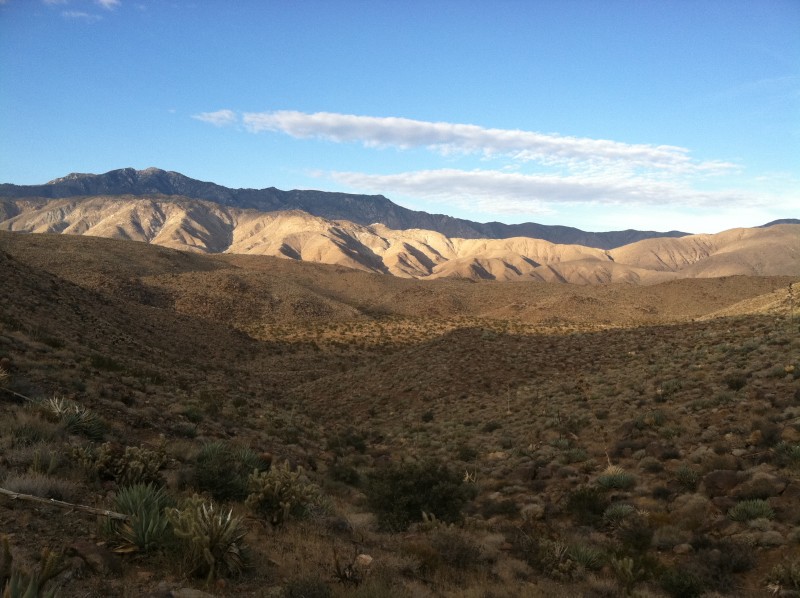Butler and Coyote Canyon Loop
Feb 28 – Mar 01 2009
Note & Warning: this trip entails a lot of cross country travel. A good map, compass, and navigation skills are required, especially when traveling between Butler and Box Canyons.
The Plan
This was a 1-½ day, 1 night backpacking trip in the Anza Borrego Desert State Park. The loop is 20 miles. Day one would be around 15 miles, and a return to my vehicle at the trail head at around noon March 1, 2009.
Elevation ranged from 984 feet to 2,809 feet. In addition, I wanted to test several items of lightweight backpacking equipment. Of particular interest was a quilt, instead of using a traditional sleeping bag. The other was a ‘soda can’ alcohol stove.
The trip starts at the trail head taking a trail up to Alcoholic Pass. The trail ends at the pass, and the rest of the trip is cross country and washers in the canyons.
Coyote Mountain separates Clark Valley from Coyote Canyon. To the south of Coyote Canyon is the sleepy village of Borrego Springs. Alcolhlic Pass is the only easy way through Coyote Mountain. In the 1800’s cattlemen would hike through Alcoholic Pass to get to Borrego Springs to drink at the bars, and hence the name Alcoholic Pass.
The picture above is a Google Earth picture of area, and the red line represents the route I hiked. Below is another Google Earth picture of the hike, but I turned it on its axis to provide a representation of the elevation of the hike. There is no water available on the loop, except for Coyote Creek, a perennial stream in Coyote Canyon. The water in this creek is hard to get to at the junction of the Box Canyon wash, due to thick reeds and is usually rather silty. It is best to hike up Coyote Creek, where the water quality improves. To avoid the extra mileage, I carried enough water to complete the hike, which was 3 liters.
Temperatures were in the mid 80’s during the day, and my camp at 2,300 feet got down to the high 40’s.
Flowers in the lower elevations where justing beginning their spring bloom. It will another month before things really bloom in the higher elevations, and it should be a good year for flowers, as there was quite a bit of rain and snow this winter. Joe and I experienced a lot of both in Butler Canyon last December.
Walking the Loop
Starting at 8:00 am, the hike immediately begins with a route up the slope to Alcoholic Pass. It is a good way to get the blood flowing and keep warm. The trail follows a rocky ridge with a quick gain of 600 feet. The Google Earth photos below provide a perspective of the elevation gain.
‘Real’ pictures of the flora and fauna at the start of the trail provide a realistic feel of the hike. Keep in mind that Google Earth is not a live feed of the earth, but archived satellite pictures. This accounts for the differences in color. Spring in the desert is often green, unlike the Google pictures. Also the satellite pictures look straight down at the earth’s surface from space, the the visual representations of terrain are computer generated models.
Above (top to bottom) Cholla cactus, Red Barrel cactus, Ocotillo, Ocotillo bloom, Arizona Lupine.
Alcoholic Pass
The pass connects Coyote Canyon to Clark Valley. It is the only easy way to cross Coyote Mountain. Originally, the Cahuilla Indians who traveled from the canyon to Clark Valley to harvest beans from Mesquite trees in the valley, which was a staple food item, used this trail.
In the 1800’s ranch hands would take the trail to Borrego Springs, which was shorter than traveling south through Clark Valley and around Coyote Mountain. Obviously, their activities in Borrego Springs were reflected in the naming of this trail.
Today Alcoholic Pass is all about the views.
Above: View of Clark Valley from Alcoholic Pass (top) and a cactus garden in Alcoholic Pass (bottom).
Google Earth pictures of Alcoholic Pass.
Clark Valley to Butler Canyon
Descending Alcoholic pass into Clark Valley the hike becomes a leisurely cross-country walk down the western slope heading northeast. Eventually I took a wash down to the floor of Clark Valley and then turned left behind a small ridge which would lead to the mouth of Butler Canyon.
Google Earth view of route to the bottom of Clark Valley Google Earth view of route to Butler canyon on the left of picture.
Some of the wild flowers on this section of the hike:
Desert Dandelion
Chuperosa
Forget-me-nots
Butler Canyon
This section provided the only challenges of the trip. First was navigating the boulder fields at the beginning of the canyon, the second was finding a relatively easy route to the playa above the canyon. Both were of little concern.
Google Earth view of Butler Canyon and the Playa.
The mouth of the canyon requires some boulder hopping, but soon it is easy hiking.
The Playa
Hiking through Butler Canyon, I needed to locate way to climb out and over the side to a plateau that separated Butler and the Box Canyon watershed. The canyon walls are steep with loose rocks and talus. Finally, a possibility was spotted. A small side canyon with a reasonable slope would bring me just north of the playa. I was able to hike diagonally across the left slope of this side canyon, and slowly work my way around a small hill, which overlooked the plateau. It would be an easy walk down the hill to the plateau and the playa.
A playa is a dry lake bed. During the rainy season, they are wet and soggy or even become a small lake. It is uncommon to find a playa in a mountainous area like this one.
Descriptions of above pictures (top to bottom):
(1) This is the side canyon that would lead out of Butler canyon. I did not travel this canyon, but immediately headed up the slope on the left. Gradually, I worked my way up and around the slope to a hill, which overlooked the completed portion of the route and the plateau.
(2) Butler Canyon. Straight below the Ocotillo is the spot where the side canyon intersects Butler. The large open area in the center of the picture is Jackass Flat.
(3) View of the plateau with Clark Valley in the background. I had already passed through that area.
(4) View the playa in the center, with the San Ysidro Mountains in the background. The hike would continue between the two small peaks beyond the playa, into the Coyote Creek watershed and the ridge I would follow which runs parallel to Box Canyon.
Above: route out of Butler Canyon to the top of the hill.
Plateau Plants
Above Box Canyon and Night Camp
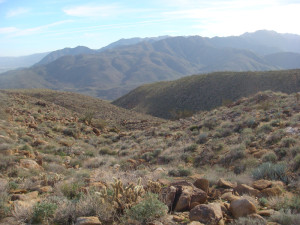 After leaving walking through the playa and entering the Coyote Canyon watershed above Box Canyon, one must stay on the ridges above the canyon, until your are close to the mouth of the canyon. There are remnants of an ancient Native American trail, but it is more work to try to find the trail, than just hiking cross-country. As the picture shows, the area is rolling and rocky. However, I made excellent time, and before 3:00PM, I had already hiked around 15 miles. I decided to head away from the ridge of Box Canyon and locate a campsite with a view. About one mile south of the canyon, I found this spot. It would provide me ample time to test a couple pieces of new gear.
After leaving walking through the playa and entering the Coyote Canyon watershed above Box Canyon, one must stay on the ridges above the canyon, until your are close to the mouth of the canyon. There are remnants of an ancient Native American trail, but it is more work to try to find the trail, than just hiking cross-country. As the picture shows, the area is rolling and rocky. However, I made excellent time, and before 3:00PM, I had already hiked around 15 miles. I decided to head away from the ridge of Box Canyon and locate a campsite with a view. About one mile south of the canyon, I found this spot. It would provide me ample time to test a couple pieces of new gear.
Trekking Poles
I have walked for decades using a single hiking staff, which weighs close to a pound. Today trekking poles have become popular, and a couple friends convinced me to try them. Supposedly, they help climb the steepest hills, are useful on descents, and steam crossings. What interested me the most were the multiple uses for setting up a shelter and hiking. I found a pair made from carbon fiber that weighed less than 4 ounces each. I suppose the jury is still out on their usefulness in hiking, but then 40 years of hiking with a single staff is a hard habit to break.
Self-portrait with the trekking poles.
Trekking poles used as tent poles for my poncho.
Camp.
Cola Can Stove Kit
My friend John Oldford, who works at MSX, suggested I try an alcohol stove made from a cat food or cola can. John has a lot of ultralight backpacking experience, as he hiked the entire 2,600+ miles of the Pacific Crest Trail in 2003. Extremely light and they use just about any kind of alcohol, but denatured alcohol works best. This set up will boil 16 ounces of water in less than 7 minutes. A nifty windscreen, called a Caldera Cone helps the efficiency of the can stove.
Above: Stove kit in sack; Stove Kit; Titanium pot/mug, alcohol fuel
bottle, stove, cone, titanium spoon, foil; close up of my Dr. Pepper can stove; Stove is in the cone and the pot slides in; and Tin foil pot cover, to save weight.
Ultralight Sleeping Set-up
I bought a light polycro piece of plastic to use as a groundsheet. Wanted to see how it would hold up, and it did well. Only weighs 1.7 ounce. The sleeping pad is folded into thirds, and it becomes the ‘frame’ and back rest when in my pack. I also used a light quilt for this trip, instead of a sleeping bag. The quilt is open on the bottom to save weight, and the sleeping pad provides insulation where the quilt is open. Last is the bivy to protect from any moisture that gets past the poncho, should it rain or snow. The bivy weighs 7.9 ounces.
Folded pad on the polycro sheet.
The pad is only 30” long, to fit under my torso. I put my Pack under my legs for insulation/padding.
Here the quilt is upside down, to show the construction.
Quilt in sleep mode.
Finished set-up, with the quilt and pad in the bivy.
The Rest of the Gear
These are a pair of Solomon trail running shoes, which weigh 29.4 ounces.
Total weight of pack and gear was just over 6 pounds.
Box Canyon
Last day of trip. I headed down a side canyon into Box Canyon, which drains into Coyote Creek. From there, it was a pleasant walk along the creek, up to Ocotillo Flats and then to my truck. Finished the hike at noon, and then drove to the Salton Sea to get a well-deserved beer!
Google Earth picture of the hike down into Canyon. You can see where I zig-zagged on that flat spot. I was following an old Indian path, and the map does not show the obstacles, which needed to be circled.
Junction of the side canyon and Box Canyon. The top of the picture shows the ridgeline above the canyon.
From junction, looking down Box Canyon.
Looking back after exiting Box Canyon.
